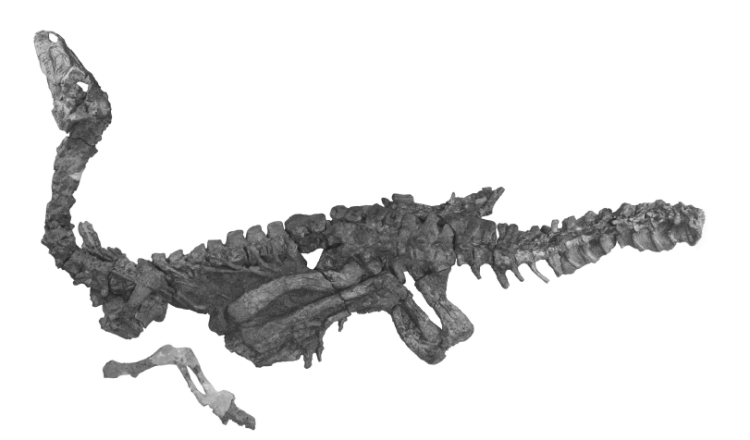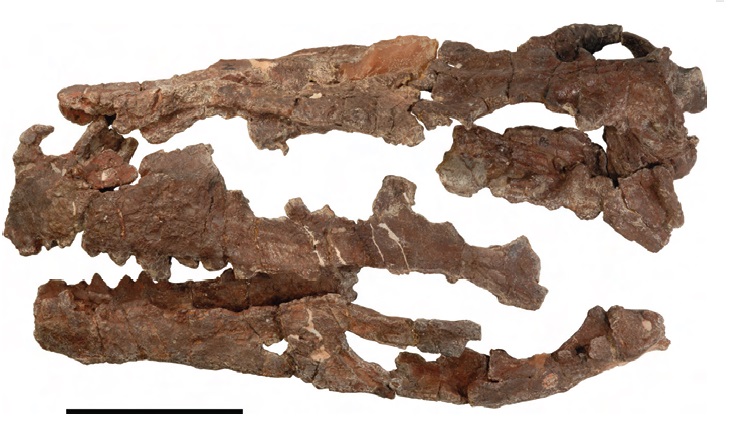
Articulated skeleton of Eoraptor lunensi (From Sereno 2013)
The oldest record of Argentinean dinosaurs comes from the Ischigualasto Formation, NW Argentina, dated from 231.4 Ma to 225.9 Ma. Adolf Stelzner in 1889 published the first data on the geology of Ischigualasto, but it was not until 1911 that Guillermo Bodenbender briefly refers to the fossils of the site. In the early 40′s, Joaquin Frenguelli, initiates a geological survey in the western margin of the basin. Later, in 1943, Angel Cabrera described fragmentary therapsid fossils. However, intensive paleontological study of the Ischigualasto and Chañares Formations, began only in the late 1950s.
The Ischigualasto Formation has 300–700 m of mudstone, sandstone, conglomerate, and basalt, and consists of four lithostratigraphic members which in ascending order include the La Peña Member, the Cancha de Bochas Member, the Valle de la Luna Member, and the Quebrada de la Sal Member. Eight valid species of dinosaurs are known from the Ischigualasto Formation: Pisanosaurus mertii, Herrerasaurus ischigualastensis, Sanjuansaurus gordilloi, Eodromaeus murphi, Eoraptor lunensis, Panphagia protos, and Chromogisaurus novasi.

Skull of Herrerasaurus ischigualastensis (Sereno, 2013)
Pisanosaurus mertii is a small specimen, know by an incomplete maxilla and lower jaw fragments bearing teeth, vertebrae, incomplete hind limb, and the impression of the pelvis. Described in 1967 by Rodolfo Casamiquela, Pisanosaurus is considered as the oldest known ornithischian.
Herrerasaurus ischigualastensis was described by Osvaldo Reig in 1963. The taxon is one of the best known Triassic dinosaurs and the largest dinosaur of the Ischigualasto Formation. Herrerasaurus was fully bipedal, with strong hind limbs, short thighs and long feet. The skull has a rectangular profile and a transversely narrow snout (Sereno and Novas, 1992). The presence of two sacral vertebrae and lack of brevis fossa made Herrerasaurus, and other herrerasaurids, a controversial group.
Sanjuansaurus gordilloi is similar to Herrerasaurus ischigualastensis, although more gracile and possessing short and straight pubis among other differences (Alcober & Martínez, 2010). It’s known from one specimen that preserves left maxilla, partial axial column, scapulae, left ulna, ungual of manual digit III, partial left ilium and pubis, both femora and tibiae, right fibula, right astragalus and calcaneum, and left metatarsal.

Skull and skeleton of Eodromaeus murphi
(PVSJ 560). Scale bar equals 10 cm.
Eodromaeus murphi is a small species with a total length of about 1.2 metres, known from five specimens. The trunk was long and slender, and forelimbs were shorter than the hindlimbs. The skull is relatively low and lightly built with a relatively spacious antorbital fenestra. A phylogenetic analysis places Eodromaeus within Theropoda as the sister taxon to Neotheropoda
Eoraptor lunensis is known from eight specimens, including the holotype that preserves most of the skeleton. Eoraptor had a slender body with an estimated weight of about 10 kilograms. The lightly built skull has a slightly enlarged external naris and the premaxilla is observed to have a slender posterolateral process. The long bones of the hind limb have more robust shafts than those of Eodromaeus, although in both genera the tibia remains slightly longer than the femur (Sereno et al., 2013). Initially considered a basal theropod, the sauropodomorph affinity of Eoraptor has been strengthened after the publication of its anatomy in 2013.
Panphagia protos is a small species, known from one partial skeleton including several skull bones, lower jaw, and partial axial skeleton. The specimen is an immature individual with an estimated body length of approximately 1.30 m. It was originally proposed as the most basal sauropodomorph (Martinez and Alcober, 2009)
Chromogisaurus novasi is also similar in size to Eoraptor lunensis. It’s known from a partial skeleton lacking the skull. It includes elements of the front and hind limbs, the pelvis and two caudal vertebrae.
References:
Martín D. EZCURRA & Ricardo N. MARTÍNEZ (2016), Dinosaur precursors and early dinosaurs from Argentina., In book: Historia Evolutiva y Paleobiogeografía de los Vertebrados de América del Sur, Publisher: Contribuciones del MACN, Editors: F. Agnolíin, G.L. Lio, F. Brissón Egli, N.R. Chimento, F. Novas, pp.97-107
Reig, O.A. (1963). “La presencia de dinosaurios saurisquios en los “Estratos de Ischigualasto” (Mesotriásico Superior) de las provincias de San Juan y La Rioja (República Argentina)”. Ameghiniana (in Spanish). 3 (1): 3–20.
Sereno, P.C.; Novas, F.E. (1992). “The complete skull and skeleton of an early dinosaur”. Science. 258 (5085): 1137–1140.
Ricardo N. Martinez; Paul C. Sereno; Oscar A. Alcober; Carina E. Colombi; Paul R. Renne; Isabel P. Montañez; Brian S. Currie (2011). “A Basal Dinosaur from the Dawn of the Dinosaur Era in Southwestern Pangaea”. Science. 331 (6014): 206–210. doi:10.1126/science.1198467
Martinez RN, Alcober OA (2009) A Basal Sauropodomorph (Dinosauria: Saurischia) from the Ischigualasto Formation (Triassic, Carnian) and the Early Evolution of Sauropodomorpha. PLoS ONE 4(2): e4397. doi:10.1371/journal.pone.0004397
Ezcurra, M. D. 2010. “A new early dinosaur (Saurischia: Sauropodomorpha) from the Late Triassic of Argentina: a reassessment of dinosaur origin and phylogeny.” Journal of Systematic Palaeontology 8: 371-425.




